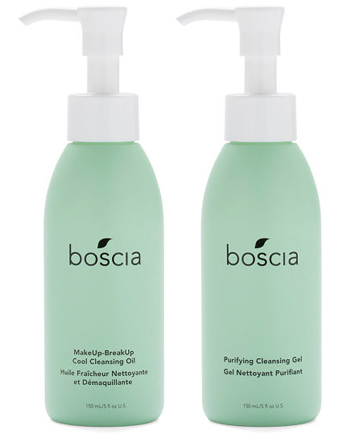If you're not yet a devotee of double cleansing, now could be a good time to try it. Simpson is always a fan of double cleansing. Double cleansing is exactly what it sounds like: Cleansing with two cleansers. Firstly, a cream or oil-based cleanser is used typically followed by a water-based one. The cleansers target different things and rid skin of impurities. Guanzon points out that double cleansing is a good method because the deep cleaning will take care of potential dirt, oil and sweat that can get trapped under many layers of sunscreen.
Worried about drying out skin? "Sunscreens don't normally strip skin of moisture, but overcleansing can," cautions Simpsons. If double cleansing, the first cleanse can be a cream-based hydrating cleanser to avoid disrupting skin's protective barrier and protect against water loss." Nourishing oil cleansers can also work.
Yes, it's called "makeup remover," but that versatile product can also help with taking off sunscreen. Guanzon suggests using it before cleansing. An oil-based makeup remover will be effective in removing oil-based sunscreens in the same way that an oil-based cleanser is.
Similarly, try a micellar water to bust through layers of sunscreen.
Simpson recommends using both a cleanser and a toner to ensure skin is fully cleansed. She cautions it's essential to choose the right products for your skin type so you don't disrupt the skin barrier when removing your SPF.
Toner will remove any remaining residue, plus, it adjusts the pH of skin so that the products layered on afterward absorb and function better.
Chemical sunscreens (ones that absorb into skin then absorb UV rays) and physical sunscreens (those that contain active mineral ingredients, like titanium dioxide or zinc oxide, and sit on top of skin to physically deflect rays) can be slightly different in application and in removal, too.
"Chemical actives will break down over time and are usually easier to wash off, while mineral sunscreens create a physical barrier of protection and require a little bit more work to remove," says Guanzon. Therefore, you might have to employ a little more elbow grease (oil-based cleansers and/or double cleansing) to remove physical-based sunscreens in their entirety.
Simpson says that for long-term daily use, physical sunscreens are usually a great choice because they can be less irritating. It's a trade-off to keep in mind.
Image via Imaxtree
Don't kill good products with poor technique. Simpson says that choosing the right formulas and cleansing with the right technique are important when avoiding skin irritation.
"Avoid scrubbing skin, instead use gentle, massaging circular motions on skin," says Simpson. "When cleansing, lighter pressure is better." If your face is turning red while cleansing, try adjusting the pressure to reduce the amount of circulation on the surface of your skin.
Skin persistently irritated during washing? This could be a sign to switch up your cleanser.
Good ingredients for sensitive skin include madecassoside, centella asiatica (aka tiger grass), aloe and chamomile.









